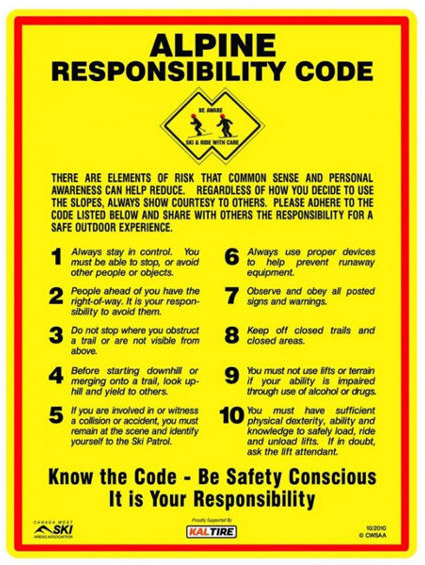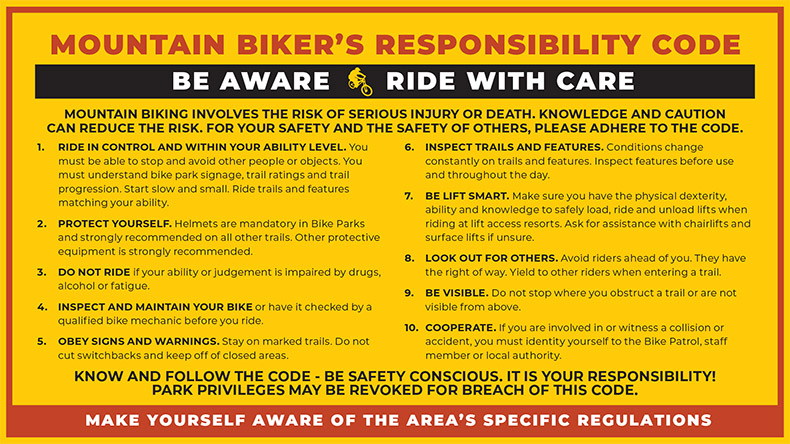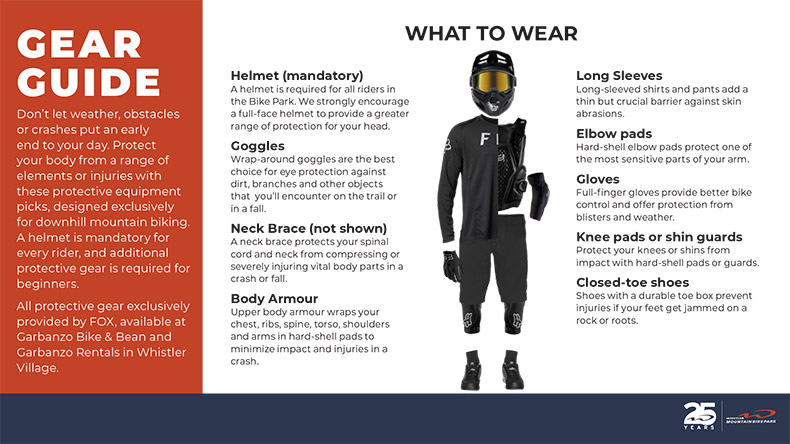All sports come with some level of risk and mountain sports even more so. With proper preparation and understanding of your own skill level, equipment and weather conditions, risks can be minimized and injuries prevented. To ensure a successful, safe and happy vacation, be sure to read through the on-mountain responsibilities, rules and regulations and always follow posted signs and the directions of the Whistler Blackcomb safety team or your activity guide.
Ski and Snowboard Safety at Whistler Blackcomb
The Alpine Responsibility Code
The points listed in the Alpine Responsibility Code are the rules of the road when you are on the mountain. The Mountain Safety Team, the Ski Patrol, and the Terrain Park Rangers will stop and let guests know when they are not following the code. Failure to follow the Alpine Responsibility Code could result in consequences ranging from a one-on-one Safety Awareness Seminar with a Ski Patroller to a lifetime suspension from Whistler Blackcomb. Learn more in this Canadian Ski Council video.

Speed and Collision Safety
Complementing the Responsibility Code, #RideAnotherDay promotes three actions every skier and rider can take to help keep themselves and those around safer on the slopes. These three actions are:
BE READY – Be ready to slow down or avoid objects or other people at any time. Ski and ride in such a way that you are always able to control yourself regardless of conditions and avoid others and objects you may encounter on the run, groomed or otherwise.
STAY ALERT – Stay alert to what’s going on around you, especially other skiers and riders. Being aware of those around and changing conditions will help you have a fun and safe day on the hill.
PLAN AHEAD – Ease up at blind spots, check uphill when merging onto trails, and give other skiers plenty of room when passing. Look out for spots on the run where traffic merges or you can’t see what’s coming next. If you are unfamiliar with a run, take it easy the first time down it and make note of places where you’ll want to slow down, such as cat tracks and rollers. Also, give other skiers and riders lots or room, especially if you are passing them. There’s plenty of space out there, so there’s no need to crowd each other.
Signs
Please respect all ropes, signage and ski area boundary markers. All may indicate possible dangers that may not be readily apparent. In particular, the snow making water reservoirs on both mountains are roped off from public access, clearly signed and should be avoided.
Helmet Usage
Whistler Blackcomb recommends wearing helmets for skiing and riding. Skiers and snowboarders are encouraged to educate themselves on the benefits and limitations of helmet usage. The primary safety consideration, and obligation under the Alpine Responsibility Code, is to ski and ride in a controlled and responsible manner.
Tree Well Information And Safety Tips
Natural hazards such as tree wells occur within and outside of the ski area boundary. A tree well is a hole or depression that forms around the base of a tree while snow accumulates. A tree well incident occurs when a person falls, head first, into an area of deep snow around the base of a tree and becomes immobilized. The more the person struggles the more entrapped in the snow they become. The risks of a tree well accident or fatality can be reduced by following these basic practices:
- Always ski or ride with a partner
- Keep your partner in sight and stay in visual contact so they can see you if you fall
- Stay close enough to either pull or dig each other out
Be Aware of Your Surroundings
- Be mindful of where you stop on the hill, for your safety and the safety of other skiers and snowboarders. When resting, move over to the side of the run. Never stop under a roller, jump, cat track, or on a blind corner, as uphill skiers will not be able to see you.
- Always be aware of other skiers and snowboarders. Look uphill before you commence downhill.
Uphill Travel
Uphill travel within the Whistler Blackcomb ski area boundary is only permitted on designated routes, marked with signage. Please respect all on-mountain signage.
Carrying Children
Whistler Blackcomb does not allow guests to ski or ride while carrying infants in any type of backpack or baby carrier. Only guests who are riding the gondola(s) up the mountain to sightsee are allowed to carry children.
Snowshoeing and Snowmobiling
Individual snowshoeing and snowmobiling are not permitted on Whistler Blackcomb Mountains for your safety and the safety of others.
Avalanche Awareness
Avalanches naturally occur in the mountains. Learn more about this natural phenomenon, and learn how to manage the risks if planning to travel in avalanche terrain. This information is useful for skiers, snowboarders, snowmobilers and those frequenting backcountry areas.
Avalanche Courses
Informative courses in avalanche safety, awareness, and terrain assessment are available through a number of places in Whistler:
The courses have been designed and recognized by the Canadian Avalanche Association. Instructors are qualified and experienced. All courses include manuals and handouts.
Free Avalanche Awareness Tours (TBA)
Free daily Avalanche Awareness Tours are run by the Whistler Blackcomb Ski Patrol in the winter. These half-day tours cover safe travel, terrain evaluation, avalanche phenomenon, control measures within boundary, avalanche safety equipment and rescue techniques. The tour meets at the Avalanche Hut at the top of the Blackcomb Gondola and leaves at 12:30 PM for a 2.5-hour tour.
Tips for Travel in Avalanche Terrain
The following are tips for travel in Avalanche terrain. These tips are not a substitute for avalanche awareness training and experience.
- Avoid large, steep, lee bowls, gullies and cornices
- Choose safer routes: ridge tops, valley floors, dense timber and low angle slopes
- Never have more than one person on a slope at any time
- Don't stop in the middle of the slope, move to a safe place
- Watch each person on the slope and stay in voice contact
- Have a plan: know who is going to go first, where to stop and where the escape route is
Whistler Mountain Bike Park Safety
Notice to all Riders, Parents and Guardians
Injuries are a common and expected part of mountain biking. We strongly suggest that full-face helmets, full length gloves, biking armour and a full suspension bike be used in the Bike Park. If you are new to the mountain biking program at Whistler Blackcomb, or the Parent or Guardian of a younger rider, please familiarize yourself with the Bike Park and the mountain biking activites we offer. Introductory mountain biking lessons and beginner terrain are available and recommended. More challenging terrain and features should not be attempted unless the rider has the appropriate skills, experience and equipment to effectively negotiate such trail sections. Please speak to Guest Services for more information regarding mountain biking at Whistler Blackcomb and check current policies when booking.
We would like to remind people to carry a mobile phone and have a local emergency contact available. We also recommend that you do not ride alone in the Bike Park. You should save the Bike Park Patrol number (604.935.5555) in your mobile phone.
Bike Park Policies
Age Policy:
- Children under 5 yrs are not permitted in the Bike Park
- Children 12 yrs and under are required to be accompanied by a parent/legal guardian (19 yrs or older) when riding in the Bike Park
- Children 13-15 yrs are strongly recommended to be accompanied by a parent/legal guardian (19 yrs or older) when riding in the Bike Park
- The parent or guardian must sign the Bike Park waiver for the child.
Brake Policy:
All bikes riding in the Whistler Mountain Bike Park must have one functioning brake per wheel. This keeps dirt jump bikes, BMX, kids with coaster brakes and beach cruisers off the trails but allows regular mountain bikes and mountain unicycles to ride on the hill. All bikes must have a functioning back brake to access the Airdome. Brakeless BMX bikes are not permitted and the practice of taping brakes on will not be tolerated hence the “functioning” clause.
Shock Recommendation:
Ensure that your suspension is tuned properly and is set up for your body weight and riding ability.
Information for Parents
The Whistler Bike Park is a significantly different experience from cross country riding. The trails require constant physical and mental effort in order for all riders to maintain control.
Bikes are permitted on the Village Gondola, Fitzsimmons Chair and Garbanzo Chair. Boarding the lift requires significant strength when loading a bike and children may require assistance. The Garbanzo Chair is NOT recommended for children as the level of difficulty and length of the trails is considerably more difficult than the lower park.
Protective clothing and equipment is mandatory for young riders. The best protection from abrasion requires a properly fitted full-faced helmet, gloves, long pants, long sleeves, leg armour, arm armour and solid running shoes.
The Bike Park trails are specifically designed for full suspension mountain bikes. The trails are rocky, bumpy and become much more difficult without high quality suspension. Without full suspension, fatigue becomes a factor much sooner. The steep grades necessitate disc brakes for adequate stopping power. Cantilever brakes will increase the fatigue factor as more effort will be required to maintain control. All Bike Park participants should ride a properly sized bike and should be able to stand over the seat with their feet flat on the ground. A bike that is too large or with a high seat post increases the risk of injury.
The level of risk increases with the level of difficulty. Black trails often have significant drops and jumps that require skill and experience to navigate. Many difficult trails have a "filter" feature at the top designed to keep riders with insufficient skills off trails that will be beyond their ability, do not ride around these features. Young riders become a hazard to other riders if they are unable to ride a trail or move out of the way. Children should be accompanied by an adult at all times and should be monitored for fatigue regularly.
Orientation Guide
It’s important to get started right. For new and first time Bike Park riders, the Orientation Guide is designed to help guests begin rolling the right way and provides important techniques for riding the Bike Park, which requires a new set of skills in order to ride safe and progress properly. Have a look at the Bike Park Orientation Guide before you hit the Park.
Mountain Bike Responsibility Code
Take a moment to familiarize yourself with the Mountain Bike Responsibility Code and keep safety your number one priority.

Mountain Bike Gear Guide
The trails of the Whistler Mountain Bike Park are rough and demanding on bike and body. Before riding, always inspect your equipment or have it checked by a qualified bike mechanic. Helmets are mandatory in the Whistler Mountain Bike Park.

Helmet Usage
Helmets are mandatory in the Whistler Mountain Bike Park.